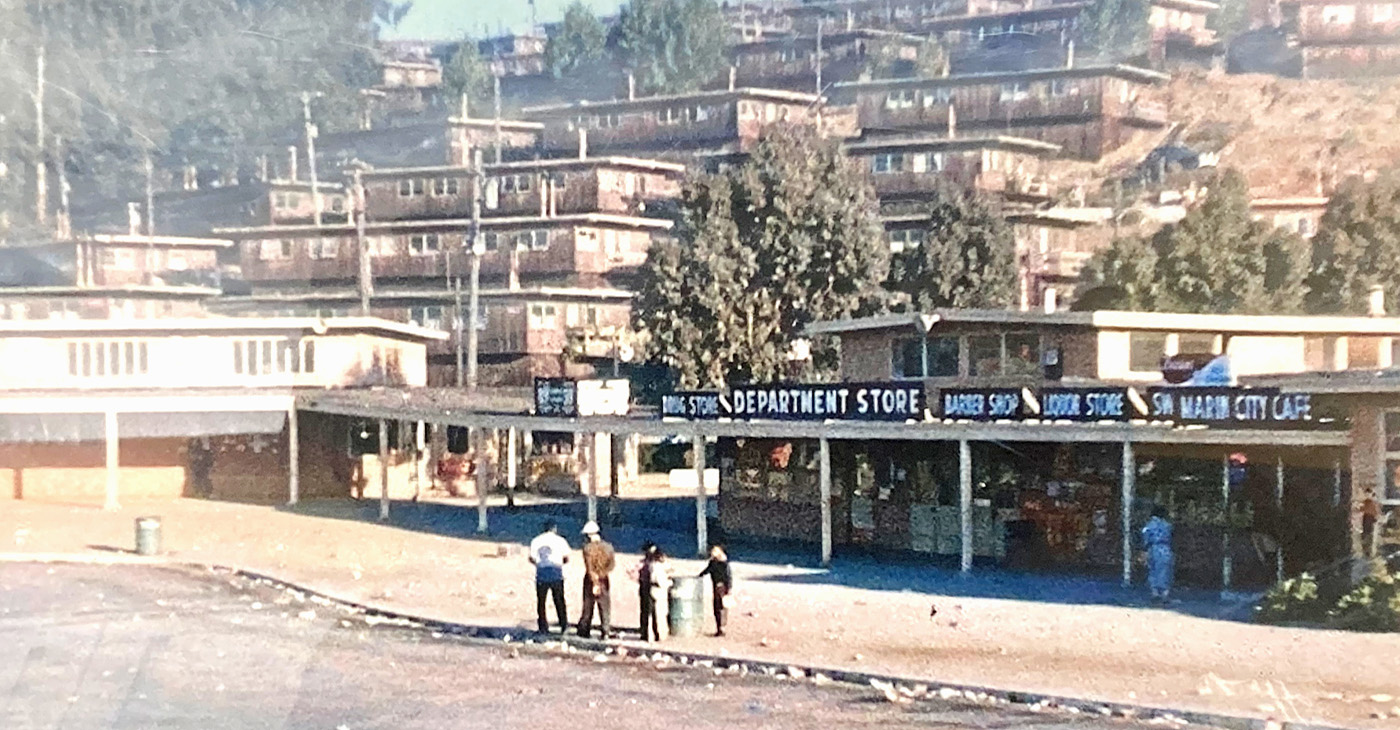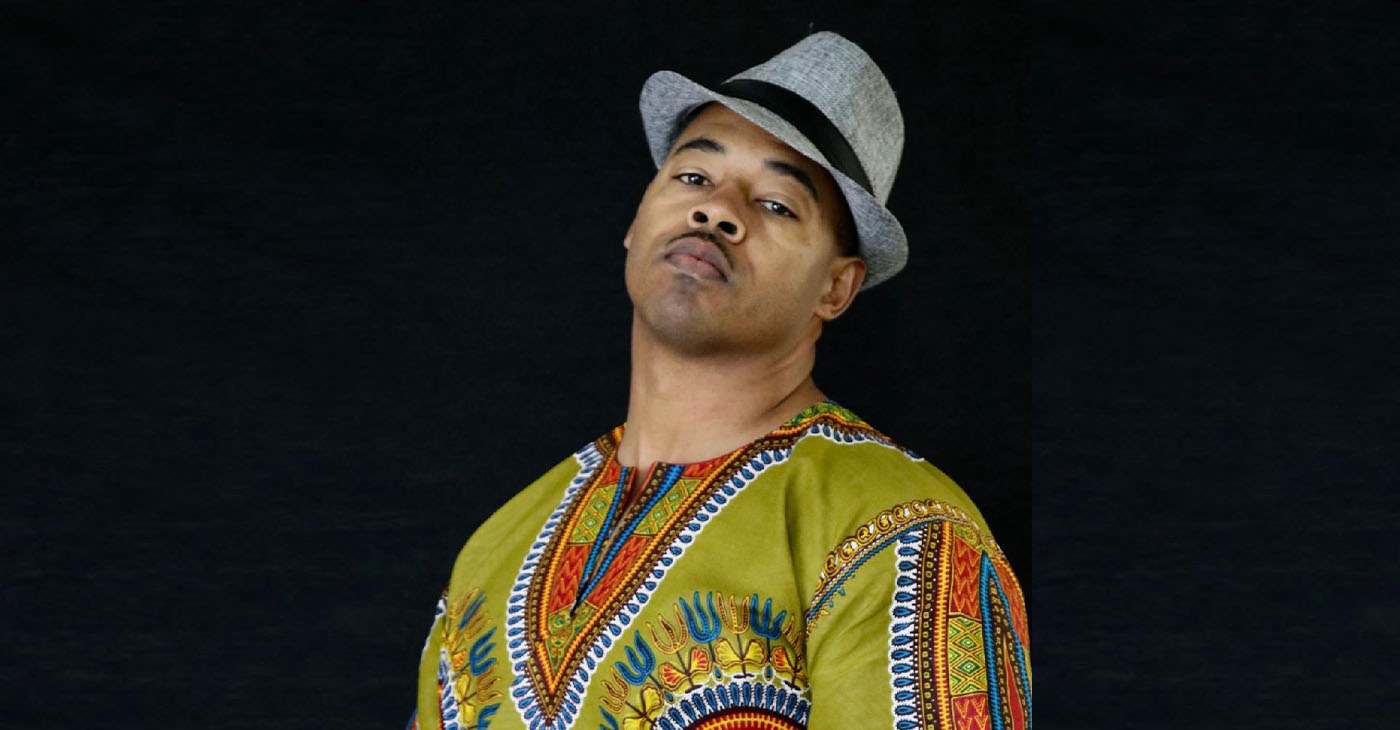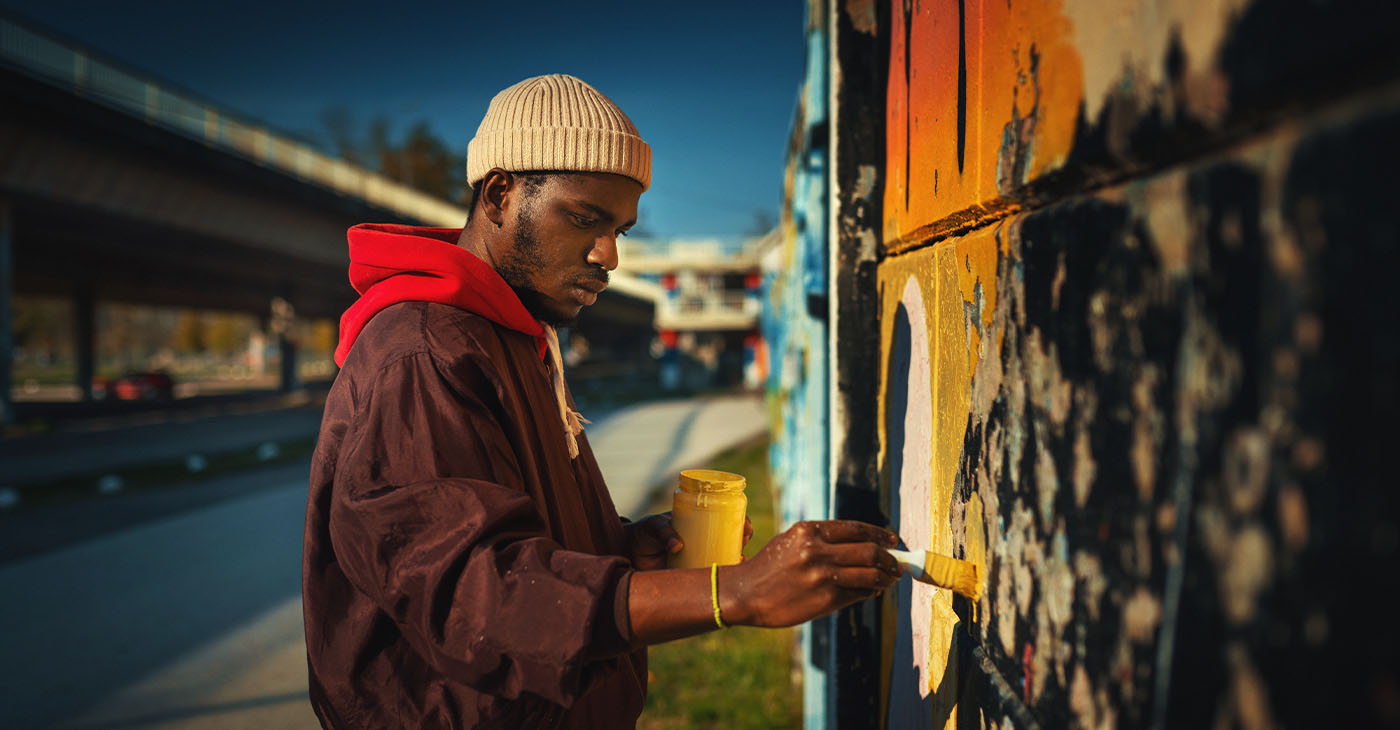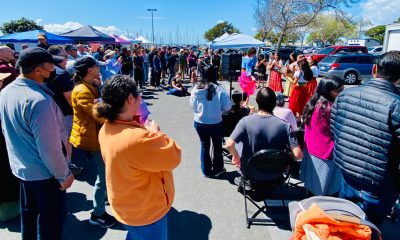Art
PRESS ROOM: CAAM Presents Exhibition On The Life And Art Of Ernie Barnes
LOS ANGELES SENTINEL — The California African American Museum (CAAM) announced today that it will present an exhibition that examines the life, art, and popularity of Ernie Barnes.
By Sentinel News Service
The California African American Museum (CAAM) announced today that it will present an exhibition that examines the life, art, and popularity of Ernie Barnes, who created some of the twentieth century’s most iconic images of African American life. Ernie Barnes: A Retrospective will be on display from May 8–September 8, 2019.
George O. Davis, Executive Director of CAAM said, “We are honored to present the work of Ernie Barnes and to tell the fascinating life story of this artist and athlete. He was a child of the segregated south who came to call Los Angeles home.”
For fans of 1970s American television, Ernie Barnes’s (1938–2009) painting The Sugar Shack is likely familiar. The 1976 work depicting a dance scene—which was the cover art for Marvin Gaye’s album I Want You—achieved cult status by regularly appearing on the hit sitcom Good Times, inspiring a community of television viewers who discussed it after each episode.
Known for his unique “neo-mannerist” approach of presenting figures through elongated forms, he captured his observations of life growing up in North Carolina, playing professional football in the NFL (1960–1964), and living in Los Angeles. Ernie Barnes: A Retrospective includes examples of his paintings of entertainment and music, and also highlights how Barnes, the official artist of the 1984 Summer Olympic Games in Los Angeles, extensively represented athletes and sports.
“While not widely known within the mainstream art world, Barnes is revered by a diverse group of collectors and admirers across the country,” said guest curator Bridget R. Cooks, Associate Professor of African American Studies and Art History at the University of California, Irvine. Ernie Barnes: A Retrospective is curated by Cooks with assistance from Vida L Brown, Visual Arts Curator and Program Manager. The Pasadena Museum of California Art originated the exhibition.
About the Artist
Ernie Barnes was born July 15, 1938 in Durham, North Carolina during the height of the Jim Crow Era. He lived in a section of the city called “The Bottom” with his parents and younger brother, James. His father, Ernest Barnes, Sr. was a shipping clerk for Liggett & Myers Tobacco Company. His mother, Fannie Geer, supervised the household for a prominent attorney who shared his extensive art book collection with the young “June” Barnes.
Bullied as a child for being shy and sensitive, Barnes found solace in drawing. In his freshman year, a weightlifting coach put Barnes on a fitness program, which taught him effort and discipline. By his senior year at segregated Hillside High School in Durham, Barnes was captain of the football team and state champion in the shot put. He earned a full athletic scholarship to North Carolina College (now North Carolina Central University) where his art instructor, sculptor Ed Wilson, encouraged him to create images from his own life experiences
In 1960, Barnes was one of thirty African Americans drafted into the National Football League, one of nine players selected that year from a Historically Black College and University. For five seasons, Barnes was an offensive lineman for the New York Titans, San Diego Chargers, and Denver Broncos. In 1965 New York Jets owner Sonny Werblin paid Barnes a season’s salary “to paint” and subsequently sponsored the first Ernie Barnes gallery exhibition. After the success of the show, Barnes retired from football at age twenty-eight and settled in Los Angeles to devote himself to art.
From his sports experience and the study of anatomy, Barnes’ unique style of elongation captures the movement, energy, and grace of his subjects. This earned him numerous awards, including “Sports Artist of the 1984 Olympic Games” and “2004 America’s Best Painter of Sports” from the American Sport Art Museum & Archives.He was commissioned to paint artwork for the National Basketball Association, Los Angeles Lakers, Carolina Panthers, New Orleans Saints, Oakland Raiders, educational institutions, corporations, musicians, celebrities, and professional athletes. His beloved painting, “The Bench,” which Barnes created in 1959 before his rookie season, was presented in 2014 to the Pro Football Hall of Fame.
His pride of North Carolina is evident in his artwork of pool halls, barbershops, porch ladies, church, street singers, sandlot games, and other memories of growing up in the South. His commentary on dance, music, sports, women, education, social justice, and everyday life continue to inspire viewers of all ages, races, religions, educational levels, and social statuses.
Barnes died of cancer on April 27, 2009.
Related Programs:
Friday, June 7, 2019 | 1:00 – 2:00 p.m.
Curatorial Walkthrough: Bridget R. Cooks
Tour Ernie Barnes: A Retrospectivewith guest curator Bridget R. Cooks, Associate Professor, Departments of African American Studies and Department of Art History at the University of California, Irvine. Cooks will offer an in-depth look at the exhibition, which features paintings, drawings, and ephemera from Barnes’s life.
Thursday, June 13, 2019 | 7:00 – 9:00 p.m.
Marvin Gaye-Oke
Get ready for a Marvin Gaye–themed karaoke night celebrating the life and work of the late Ernie Barnes, led by soul singer Torrénce Brannon-reese!This night of song is presented in conjunction with Ernie Barnes: A Retrospective,which includes Barnes’s famous painting The Sugar Shack, which was featured on the cover of Gaye’s I Want You album.
About the California African American Museum
CAAM explores the art, history, and culture of African Americans, with an emphasis on California and the West. Chartered by the State of California in 1977, the Museum began formal operations in 1981 and is a state-supported agency and a Smithsonian Affiliate. In addition to presenting exhibitions and public programs, CAAM houses a permanent collection of more than four thousand works of art, artifacts, and historical documents, and a publicly accessible research library containing more than twenty thousand volumes.
Visitor Information
Admission to the California African American Museum is free. Visit caamuseum.org for current exhibition and program information or call 213-744-7432 for tours or additional assistance.
Hours: Tuesday–Saturday 10 a.m.–5 p.m., Sunday 11 a.m.–5 p.m. Closed Mondays and national holidays. The California African American Museum is located in Exposition Park at the corner of Figueroa Street and Exposition Boulevard, west of the 110 (Harbor) Freeway. Easy parking is available for $12 (cash only) at 39thand Figueroa Streets. The Metro Expo line stop Expo Park/USC is a five-minute walk through the Exposition Park Rose Garden to the Museum.
This article originally appeared in the Los Angeles Sentinel.
Art
Marin County: A Snapshot of California’s Black History Is on Display
The Marin County Office of Education, located at 1111 Las Gallinas Ave in San Rafael, will host the extraordinary exhibit, “The Legacy of Marin City: A California Black History Story (1942-1960),” from Feb. 1 to May 31, 2024. The interactive, historical, and immersive exhibit featuring memorabilia from Black shipyard workers who migrated from the South to the West Coast to work at the Marinship shipyard will provide an enriching experience for students and school staff. Community organizations will also be invited to tour the exhibit.

By Post Staff
The Marin County Office of Education, located at 1111 Las Gallinas Ave in San Rafael, will host the extraordinary exhibit, “The Legacy of Marin City: A California Black History Story (1942-1960),” from Feb. 1 to May 31, 2024.
The interactive, historical, and immersive exhibit featuring memorabilia from Black shipyard workers who migrated from the South to the West Coast to work at the Marinship shipyard will provide an enriching experience for students and school staff. Community organizations will also be invited to tour the exhibit.
All will have the opportunity to visit and be guided by its curator Felecia Gaston.
The exhibit will include photographs, articles and artifacts about the Black experience in Marin City from 1942 to 1960 from the Felecia Gaston Collection, the Anne T. Kent California Room Collection, The Ruth Marion and Pirkle Jones Collection, The Bancroft Library, and the Daniel Ruark Collection.
It also features contemporary original artwork by Chuck D of the Rock and Roll Hall of Fame group Public Enemy, clay sculptures by San Francisco-based artist Kaytea Petro, and art pieces made by Marin City youth in collaboration with Lynn Sondag, Associate Professor of Art at Dominican University of California.
The exhibit explores how Marin City residents endured housing inequities over the years and captures the history of plans to remove Black residents from the area after World War II. Throughout, it embodies the spirit of survival and endurance that emboldened the people who made Marin City home.
Felecia Gaston is the author of the commemorative book, ‘A Brand New Start…This is Home: The Story of World War II Marinship and the Legacy of Marin City.’ Thanks to the generous contribution of benefactors, a set of Felecia’s book will be placed in every public elementary, middle, and high school library in Marin.
In addition, educators and librarians at each school will have the opportunity to engage with Felecia in a review of best practices for utilizing the valuable primary sources within the book.
“Our goal is to provide students with the opportunity to learn from these significant and historical contributions to Marin County, California, and the United States,” said John Carroll, Marin County Superintendent of Schools.
“By engaging with Felecia’s book and then visiting the exhibit, students will be able to further connect their knowledge and gain a deeper understanding of this significant historical period,” Carroll continued.
Felecia Gaston adds, “The Marin County Office of Education’s decision to bring the Marin City Historical Traveling Exhibit and publication, ‘A Brand New Start…This is Home’ to young students is intentional and plays a substantial role in the educational world. It is imperative that our community knows the contributions of Marin City Black residents to Marin County. Our youth are best placed to lead this transformation.”
The Marin County Office of Education will host an Open House Reception of the exhibit’s debut on Feb. 1 from 4 p.m. – 6 p.m.. All school staff, educators, librarians, and community members are encouraged to attend to preview the exhibit and connect with Felecia Gaston. To contact Gaston, email MarinCityLegacy@marinschools.org
Activism
Alternative Outcome to Slayings by Police Explored in One-Man Play
BLACK MEN EVERYWHERE! is the explosive new one man play written, directed, and performed by Jinho “Piper” Ferreira. Set against the backdrop of a presidential election, the play explores how political and cultural leaders wield the myth of the dangerous Black man to manipulate the masses for personal gain. Piper penned the follow-up to his ground-breaking solo play, “Cops and Robbers,” after an impromptu cross-country Black history tour.

Special to The Post
What would happen if police officers who have gotten off for killing unarmed Black people started turning up dead?
BLACK MEN EVERYWHERE! is the explosive new one man play written, directed, and performed by Jinho “Piper” Ferreira. Set against the backdrop of a presidential election, the play explores how political and cultural leaders wield the myth of the dangerous Black man to manipulate the masses for personal gain.
Piper penned the follow-up to his ground-breaking solo play, “Cops and Robbers,” after an impromptu cross-country Black history tour.
“My wife and I had been talking about it for years,” Ferreira said. They had taken their three children to Brazil several times and West Africa but had yet to explore their history as Black people in this country. “It was Juneteenth last year and I realized we had a few weeks to make it happen, so we just jumped in the car and left” Piper said.
Three weeks later the family had seen everything from the African American Museum of History and Culture in Wash., D.C., to the phenomenally preserved Whitney Plantation in Louisiana. They’d stood outside of the balcony of the Lorraine Hotel where Dr. Martin Luther King Jr. was assassinated in Memphis, Tenn., walked across the Edmund Pettus Bridge in Selma, Ala., and paid their respects at the Africa Town cemetery – where the passengers of the Clotilda (the last known U.S. slave ship to smuggle captured Africans into this country) were buried near Mobile, Ala.
“We had the kids keep a journal of the trip and my wife and I took notes, but once we got back home, I knew I had to make the pen move,” he said.
Ferreira plays 21 characters in the 60-minute emotional roller coaster ride; personalities we all know. While brilliantly weaving in themes of revolution, treachery, and revenge, “Black Men Everywhere!” is surprisingly — more than anything else — a love story.
“I wrote the play for Black men and everyone who loves us,” Ferreira said. “The play is narrated by a sistah and performed in front of the deeply spiritual artwork of Nedra T. Williams, an Oakland priestess of Olokun. It’s called ‘Black Men Everywhere!’ but we don’t exist without the Black woman.”
For tickets, please go to: http://tinyurl.com/5dm3mhra
Art
City of Stockton Seeks Applications for Public Art Murals
The City of Stockton Arts Commission (SAC) has announced the opportunity for artist(s) and/or artist teams to apply to design and paint original artwork on City-owned property through a Public Art Mural Program. The deadline for applications is Friday, March 8, 2024, at 5 p.m. Applications and additional information are available online at www.stocktonca.gov/publicart.

City of Stockton
The City of Stockton Arts Commission (SAC) has announced the opportunity for artist(s) and/or artist teams to apply to design and paint original artwork on City-owned property through a Public Art Mural Program.
The deadline for applications is Friday, March 8, 2024, at 5 p.m. Applications and additional information are available online at www.stocktonca.gov/publicart.
The Public Art Mural Program incentivizes mural installations by providing city funding and the means of curating the City’s collection of murals.
This program has $50,000 in available funds for artist(s) and is also available for those who have already identified funds and would like to complete a mural project on city-owned property. Applications will be reviewed on a competitive basis and selected by the SAC.
To learn more about the Stockton Arts Commission (SAC) or qualifications and eligibility for Public Art Mural Program, please visit www.stocktonca.gov/publicart or call the Community Services Department at (209) 937-8206.
-

 Activism4 weeks ago
Activism4 weeks agoOakland Post: Week of March 27 – April 2, 2024
-

 #NNPA BlackPress4 weeks ago
#NNPA BlackPress4 weeks agoCOMMENTARY: D.C. Crime Bill Fails to Address Root Causes of Violence and Incarceration
-

 #NNPA BlackPress4 weeks ago
#NNPA BlackPress4 weeks agoMayor, City Council President React to May 31 Closing of Birmingham-Southern College
-

 #NNPA BlackPress4 weeks ago
#NNPA BlackPress4 weeks agoBeloved Actor and Activist Louis Cameron Gossett Jr. Dies at 87
-

 Community1 week ago
Community1 week agoFinancial Assistance Bill for Descendants of Enslaved Persons to Help Them Purchase, Own, or Maintain a Home
-

 Activism3 weeks ago
Activism3 weeks agoOakland Post: Week of April 3 – 6, 2024
-

 Business1 week ago
Business1 week agoV.P. Kamala Harris: Americans With Criminal Records Will Soon Be Eligible for SBA Loans
-

 Activism2 weeks ago
Activism2 weeks agoOakland Post: Week of April 10 – 16, 2024





















































